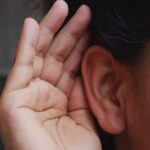Discriminative Listening explained

Discriminative Listening: this article explains discriminative listening in a practical way. This article contains a general definition of the process, the meaning of discriminative listening and practical examples. After reading it you will understand the basics of this communication skill and theory. Enjoy reading!
What is discriminative listening? The basics and theory
Listening is a core competency that helps people make progress in life. Listening is an active process of paying attention to sounds. The active listening process consists of several steps, including receiving, selecting, interpreting, understanding, evaluating and responding to a message.
If one of these steps is not done, you are not listening properly. There are many different ways to listen. Each way is useful and is used in different scenarios and circumstances.
Knowing that there are different types of listening, such as active listening, analytical listening, and therapeutic listening, is helpful in being a good listener.
Definition of discriminative listening
Discriminative listening is a type of listening in which the listener assigns meaning to sounds rather than words. It is therefore mainly about hearing nuances and differences in sounds and body language.
The listener focuses on characteristics such as speed, intonation and pitch. This is the most basic form of listening and is developed right from birth. Recognizing the interpretation of regional accents is an example of discriminative listening.
Some examples of discriminative listening
As indicated, this form of listening is developed from moments after birth. After a short period of time, the child begins to recognize different voices, for example those of the mother and the father. Research has also shown that the child reacts differently to these voices.
Among other things, discriminative listening enables us to distinguish between male and female voices.
In addition, it is also possible to distinguish how many people are talking at the same time, the different accents of these people and the way of speaking, plus intonation. Various signals can be derived from this, including the emotions hidden behind the sound.
For example, it is possible to determine that something is wrong with someone if they sound depressed and sad, when this person is usually cheerful and energetic.
Another example often occurs in front of a class of young students. A teacher usually teaches with an informative tone. If this teacher then addresses a child harshly and sternly because he is not paying attention, it is easy to determine that the teacher does not accept this behavior and changes his mood. Also, in this example it is discriminative listening that makes it possible to receive these signals.
Now It’s Your Turn
What do you think? Do you recognize the explanation about discriminative listening? In which situations is discriminative listening even more important? Can discriminative listening be developed or improved? What other forms of listening do you use on a daily basis? Do you have any tips or comments?
Share your experience and knowledge in the comments box below.
More information
- Wolvin, A. D., & Coakley, C. G. (1985). Listening. Wm. C. Brown Publishers.
- Welch, S. A., & Mickelson, W. T. (2013). A listening competence comparison of working professionals. International Journal of Listening, 27(2), 85-99.
- Stewart, M. C., & Arnold, C. L. (2018). Defining social listening: Recognizing an emerging dimension of listening. International Journal of Listening, 32(2), 85-100.
How to cite this article:
Janse, B. (2022). Discriminative Listening. Retrieved [insert date] from Toolshero: https://www.toolshero.com/communication-methods/discriminative-listening/
Published on: 02/21/2022 | Last update: 11/08/2023
Add a link to this page on your website:
<a href=”https://www.toolshero.com/communication-methods/discriminative-listening/”>Toolshero: Discriminative Listening</a>












